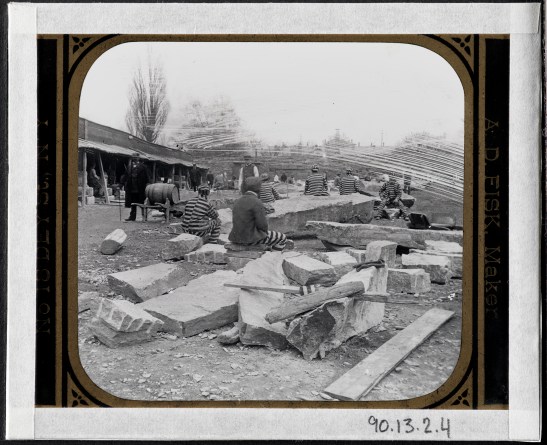MCNY Blog: New York Stories
Iconic photos of a changing city, and commentary on our Collections & Exhibitions from the crew at MCNY.org
Lunatics, Inmates, and Homeowners: The History of Roosevelt Island
The nurses plunged her into an ice-cold bath, pulled her out sopping wet, and threw a sheer flannel slip over her head. Large black letters spelled “Lunatic Asylum, B.I., H. 6.” across the garment. Nellie Brown, the now-freezing woman, was relegated to Blackwell’s Island, Hall 6.
However, all was not as it appeared. In reality, the name Nellie Brown served as a pseudonym for Nellie Bly, an investigative reporter who exposed the abuses of the Lunatic Asylum in 1887 for the New York World. She feigned insanity in order to be committed to the ward, where she stayed for ten days and nights. Her experience on Blackwell’s Island, later known as Welfare Island and currently called Roosevelt Island (in honor of Franklin D. Roosevelt), represents just one piece in the island’s storied history.

Byron Company. Hospital, Bellevue, Blackwell’s Island (Welfare) Old & New Bldgs., ca. 1896. Museum of the City of New York. 93.1.1.4876

In her book, Ten Days in a Mad-House, Nellie Bly describes the “moth-eaten shawl” she was given to ward off the cold. Byron Company. Hospital, Bellevue, Blackwell’s Island (Welfare) Old & New Bldgs., ca. 1896. Museum of the City of New York. 93.1.1.4918
The island, located in the East River, was originally referred to as Minnehanonck by local Native Americans, who eventually sold it to Wouter van Twiller, the Dutch East Indies employee who succeeded Peter Minuit as Director-General of New Amsterdam. In 1668, Captain John Manning purchased the property. His son-in-law, Robert Blackwell, then acquired the land, which he used for farming. After New York City gained ownership of the island in 1828, construction began on a series of public institutions, including a prison, an almshouse, and several hospitals. Although the penitentiary was eventually moved to Rikers Island in 1935, early inmates quarried stone to build one of the hospitals. Eventually the thin strip of land became known as “Welfare Island” because the prison and the workhouse gained a reputation for overcrowding, violence, and drug trafficking.

Byron Company. Hospital, Bellevue, Blackwell’s Island (Welfare) Old & New Bldgs., ca. 1896. Museum of the City of New York. 93.1.1.4863

Jacob August Riis (1849-1914). Blackwell’s Island. Prisoners Breaking Stone, ca. 1890. Museum of the City of New York. 90.13.2.4

Henry Granger Piffard (1842-1910), Jacob August Riis (1849-1914). Blackwell’s Island. The Lock-step Penitentiary, ca. 1890. Museum of the City of New York. 90.13.2.3

Byron Company. Hospital, Bellevue, Blackwell’s Island (Welfare) Old & New Bldgs., ca. 1896. Museum of the City of New York. 93.1.1.4915
Despite years of neglect, the island finally began to transform. Two architects, Philip Johnson and John Burgee, envisioned a waterfront paradise inhabited by a variety of residents from diverse socioeconomic backgrounds. In the 1970s, New York State initiated a plan to develop the property into a residential community, which accommodated working- and middle-class families. By the 1980s, the island’s reputation continued to improve, attracting residents to its quiet neighborhoods connected to Manhattan by an aerial tramway. When luxury apartments began to appear in the early 2000s, residents expressed concerns that affordable housing would vanish. For the most part, however, regulations have ensured that rent-regulated units remain available.
![[Queensboro Bridge and Roosevelt Island Tramway.]](https://blog.mcny.org/wp-content/uploads/2015/02/2013-3-2-1877_tramway.jpg?w=547&h=437)
Edmund V. Gillon (1929-2008). [Queensboro Bridge and Roosevelt Island Tramway.], ca.1981. Museum of the City of New York. 2013.3.2.1877
![[Octagon Tower.]](https://blog.mcny.org/wp-content/uploads/2015/02/2013-3-1-570_octagon-tower.jpg?w=547&h=680)
Edmund V. Gillon (1929-2008). [Octagon Tower.], 1970-2000. Museum of the City of New York. 2013.3.1.570
If you’re interested in New York City’s myriad mystery islands, join us Thursday, March 26, 2015 at 6:30 for The Last Unknown Place in New York City: A Conversation with Christopher Payne & Michael Miscione.
Bibliography
“A New Space for a Timeless Vision.” Creating Franklin D. Roosevelt Four Freedoms Park: The Persistence of an Idea. FDR 4 Freedoms, n.d. Web. 08 Mar. 2015. <http://fdr4freedoms.org/franklin-d-roosevelt-four-freedoms-park/>.
Bellafante, Ginia. “Affordable Island in the Sun: Roosevelt Island Maintains Its Mix.” The New York Times. The New York Times, 20 June 2014. Web. 09 Mar. 2015. <http://www.nytimes.com/2014/06/22/nyregion/roosevelt-island-maintains-its-mix.html>.
Bly, Nellie. Ten Days in a Mad-House. New York: Ian L. Munro, 1887.Undercover Reporting: Deception for Journalism’s Sake: A Database. New York University. Web. 13 Feb. 2015.
“History of the Octagon.” The Octagon. The Octagon, n.d. Web. 08 Mar. 2015. <http://www.octagonnyc.com/history>.
Jackson, Kenneth T., ed. The Encyclopedia of New York. Second ed. New Haven: Yale UP, 2010. Print.


For more history of Roosevelt Island check out our website rihs.us. We hav the largest collection of Roosevelt Island history, artifacts and photographs.
Judith Berdy, President
Roosevelt island Historical Society
rooseveltislandhistory@gmail.com
I am surprised this article does not mention that Julia de Burgos, one of Puerto Rico’s most famous poets who lived and died in New York City, stayed at Memorial Hospital and wrote a poem about it entitled “Farewell from Welfare Island.” She was honored with a U.S. Postal stamp in 2010.
Pingback: Homeless Hypocrisy Always Has A Home in New York – and Elsewhere | Saying the Unsaid in New York
Pingback: Wicked Within Podcast